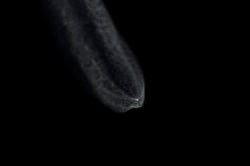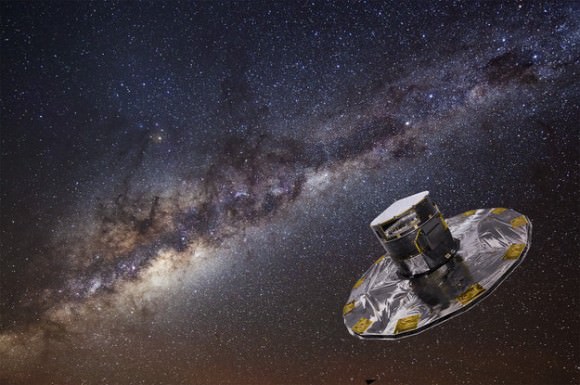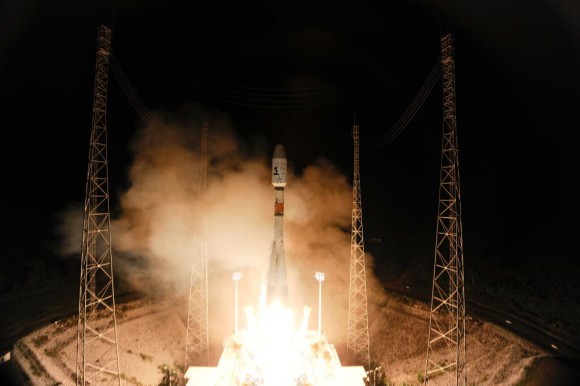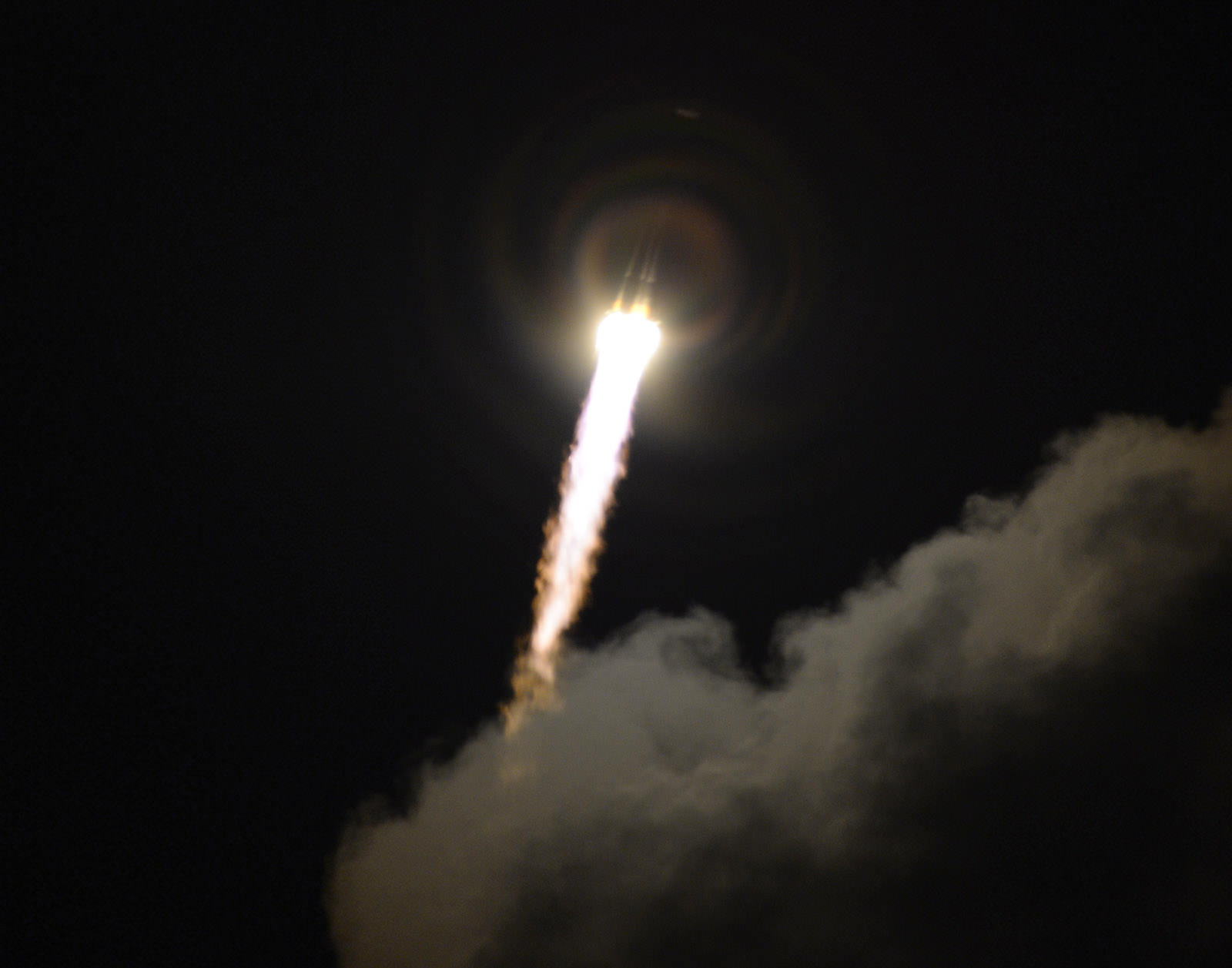Early this morning, at 09:12 UTC, the cloudy pre-dawn sky above the coastal town of Kourou, French Guiana was brilliantly sliced by the fiery exhaust of a Soyuz VS06, which ferried ESA’s “billion-star surveyor” Gaia into space to begin its five-year mission to map the Milky Way.
Ten minutes after launch, after separation of the first three stages, the Fregat upper stage ignited, successfully delivering Gaia into a temporary parking orbit at an altitude of 175 km (108 miles). A second firing of the Fregat 11 minutes later took Gaia into its transfer orbit, followed by separation from the upper stage 42 minutes after liftoff. 46 minutes later Gaia’s sunshield was deployed, and the spacecraft is now cruising towards its target orbit around L2, a gravitationally-stable point in space located 1.5 million km (932,000 miles) away in the “shadow” of the Earth.
The launch itself was really quite beautiful, due in no small part to the large puffy clouds over the launch site. Watch the video below:
A global space astrometry mission, Gaia will make the largest, most precise three-dimensional map of our galaxy by surveying more than a billion stars over a five-year period.
“Gaia promises to build on the legacy of ESA’s first star-mapping mission, Hipparcos, launched in 1989, to reveal the history of the galaxy in which we live,” says Jean-Jacques Dordain, ESA’s Director General.

Repeatedly scanning the sky, Gaia will observe each of the billion stars an average of 70 times each over the five years. (That’s 40 million observations every day!) It will measure the position and key physical properties of each star, including its brightness, temperature and chemical composition.
By taking advantage of the slight change in perspective that occurs as Gaia orbits the Sun during a year, it will measure the stars’ distances and, by watching them patiently over the whole mission, their motions across the sky.
The motions of the stars can be put into “rewind” to learn more about where they came from and how the Milky Way was assembled over billions of years from the merging of smaller galaxies, and into “fast forward” to learn more about its ultimate fate.
“Gaia represents a dream of astronomers throughout history, right back to the pioneering observations of the ancient Greek astronomer Hipparchus, who catalogued the relative positions of around a thousand stars with only naked-eye observations and simple geometry. Over 2,000 years later, Gaia will not only produce an unrivaled stellar census, but along the way has the potential to uncover new asteroids, planets and dying stars.”
– Alvaro Giménez, ESA’s Director of Science and Robotic Exploration

Of the one billion stars Gaia will observe, 99% have never had their distances measured accurately. The mission will also study 500,000 distant quasars, search for exoplanets and brown dwarfs, and will conduct tests of Einstein’s General Theory of Relativity.
“Along with tens of thousands of other celestial and planetary objects,” said ESA’s Gaia project scientist Timo Prusti, “this vast treasure trove will give us a new view of our cosmic neighbourhood and its history, allowing us to explore the fundamental properties of our Solar System and the Milky Way, and our place in the wider Universe.”
Follow the status of Gaia on the mission blog here.
Source: ESA press release and Gaia fact sheet



There are a lot of space missions, and you can try to compare their relative importance, but this mission might provide the most significant data for advancing astronomy this decade.
Most important in 400 years, even!
With respect to truly classical astronomy, by which I mean the ancient human question:
“Twinkle, twinkle, little star,
How I wonder where you are.”
No eyepiece on Earth can add to the knowledge of where any star is, after Gaia. History books will note two turning points in classical astronomy:
Galileo and Gaia.
(No pretty images though, just a billion random dots)
5 years of information gathering, 50 years of science workout. (Or so i read in local paper). From designing & launcing Gaia, to data management & final science papers. … UT fits in there somewhere too.
Some even hope to identify individual Oort belt objects by micro gravity lensing from Gaia data. Way off anything imagined during mission design. Clever people will squeeze everything out of this.
Not in a shadow. It orbits at L2 only to remain at constant distance from the Sun. It is in full sunlight all the time, that is what gives it energy by its solar panels. Going into the shadow of Earth is what will kill the mission after 6.3 years, because the thermal shock of that transition will destroy its precision. Orbiting L2 cannot be reasonably done longer than that, according to extremely elaborate calculations.
That’s what I’ve read on ESA website, and had explained to me by very patient people, anyway. And here:
http://upcommons.upc.edu/pfc/bitstream/2099.1/8131/1/memoria.pdf
Er.. Jason did enclose the term shadow within quotation marks, so he did not mean it literally.
In spite of the use of quotation marks, I still find somewhat unfortunate to use the term Earth “shadow”, as one very important requirement of Gaia orbit is to avoid this shadow at any cost.
Actually, the Sun–Earth L_2 point is slightly beyond the reach of the Earth’s umbra, so solar radiation is not completely blocked.
Ok, no, Gaia will not literally be in the penumbral shadow of the planet. But its position at L2 does “shadow” the Earth, in that it’s on the opposite side from the Sun (as opposed to “behind” the planet as I’ve also heard it described, which could be interpreted to mean following Earth in its orbit.) So in using that word I wasn’t scientifically accurate. I hoped the quotes and link would help.
In spite of the use of quotation marks, I still find somewhat unfortunate to use the term Earth “shadow”, as one very important requirement of Gaia orbit is to avoid this shadow at any cost.
A VERY important mission! No doubt serendipity will also play a role? Hope so… Expect the unexpected? WHO KNOWS what those billion pixel eyes may see? Cosmic scale entanglement as radiated from the initial singularity? FTL Starship slipstreams near black holes? Anything goes? LOL
I wonder why are they using a Soyuz launcher for this mission. Is there any advantage in cost, payload capacity -power or reliability compared to say, Ariane rockets?
Lets hope all goes well during its long exploration of our own galaxy. The chips that provide the stunning images from SDO, Curiosity and now Gaia are made by British Company e2V a real combined effort.
Roseland Observatory
I liked the little girl looking at stars painted on the final stage. Anyone know the story behind it?
It was designed by Joël Schopfer — there’s a story here: http://blogs.esa.int/gaia/2013/12/03/the-story-of-our-fairing-logo/
Thanks